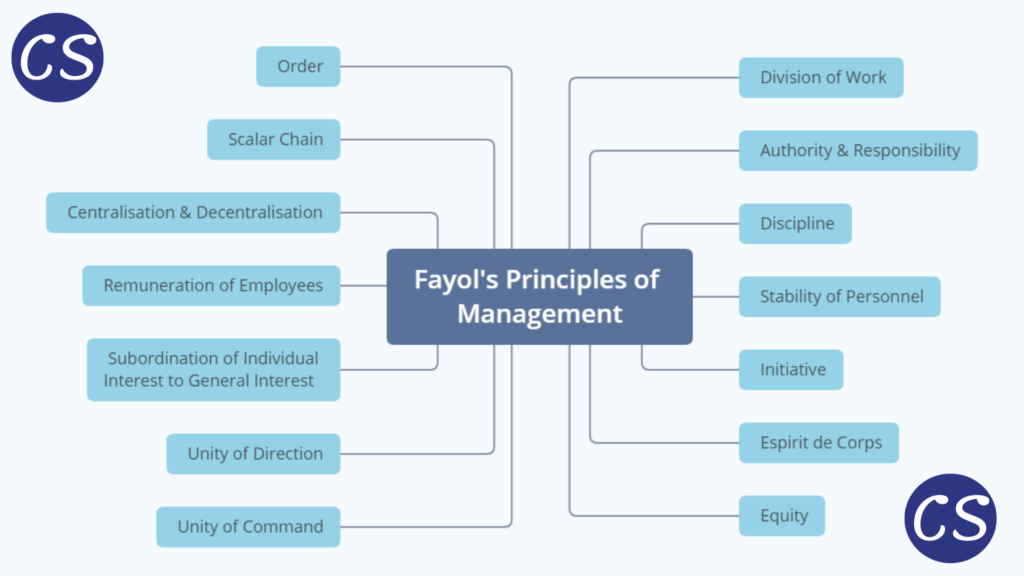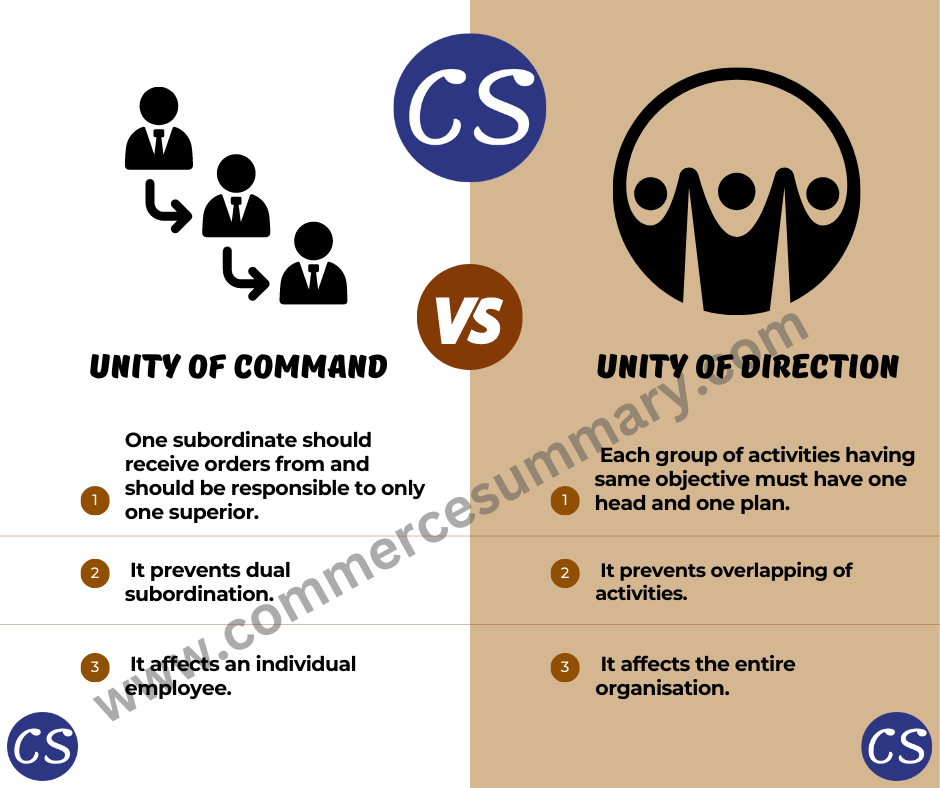Introduction
In modern management, understanding effective principles is crucial for success. Henry Fayol’s 14 Principles of Management, developed by the French industrialist and theorist, are influential and continue to shape contemporary practices. This article explores each principle with real-life examples, providing valuable insights for enhancing managerial skills and organizational performance.

Diagram showing All 14 principles in one Chart.
Table of Contents
Table of Contents
1. Principle of Division of Work
Definition and Explanation
According to The principle of division of work, complex tasks should be broken down into smaller and more manageable parts. By doing so, efficiency and productivity are maximised as employees can focus on their specific areas of expertise. This principle also highlights the importance of specialisation, where individuals can develop their skills and become experts in their respective fields.
Real-Life Example
In a smartphone manufacturing plant, the assembly line is a classic example of the division of work. Each worker is assigned specific tasks, such as attaching screens, installing batteries, or testing camera modules. This specialisation leads to increased productivity and the timely production of smartphones.
2. Principle of Authority and Responsibility
Definition and Explanation
Authority refers to the right of a manager to give orders and make decisions, while responsibility is the obligation to perform assigned tasks. According to this principle, authority should be accompanied by an equal level of responsibility. This ensures that those in charge are accountable for their actions and decisions.
Real-Life Example
In a software development firm, the project manager has the authority to make decisions about the project’s direction and allocate resources accordingly. However, they also bear the responsibility for meeting project deadlines and delivering a high-quality product.
3. Principle of Discipline
Definition and Explanation
Discipline in the workplace is crucial for maintaining order and efficiency. It involves employees following the established rules and regulations, respecting authority, and working towards the organisation’s goals. A disciplined workforce ensures a smooth and harmonious work environment.
Real-Life Example
A restaurant kitchen is a place that requires strict discipline. Each chef and cook must follow standardised recipes, cooking techniques, and hygiene practices to deliver consistent and delightful dishes to customers.
4. Unity of Command
Definition and Explanation
The principle of unity of command says that employees should have only one direct supervisor. This minimises confusion and conflicts arising from overlapping instructions and ensures clear communication channels within the organisation.
Real-Life Example
In military operations, the principle of unity of command ensures that soldiers receive clear and concise instructions from their commanding officers. This hierarchical structure minimises confusion and facilitates effective execution on the battlefield.
5. Unity of Direction
Definition and Explanation
According to Unity of direction, All efforts and actions should be aligned to achieve the organisation’s objectives. It emphasises the importance of having a unified approach that guides all individuals towards the same organisational objectives. This ensures everyone is working together harmoniously towards common goals.
Real-Life Example
A product development team in a tech company follows the principle of unity of direction by working together towards a common goal – creating a successful product. All team members are aligned with the same vision, ensuring an associative effort.

6. Subordination of Individual Interest to the General Interest
Definition and Explanation
According to this principle, the overall goals and objectives of the organisation must be given priority over the interest of the individual employees.
Real-Life Example
In a non-profit organisation, volunteers work together with a shared passion for the cause, despite individual differences.
7. Principle of Remuneration
Definition and Explanation
Remuneration refers to the compensation and benefits provided to employees for their work. This principle suggests that fair and reasonable remuneration is essential to motivate employees and ensure their loyalty to the organisation.
Real-Life Example
A successful salesperson in a commission-based retail environment earns bonuses and incentives based on their sales performance. This motivates them to achieve higher sales targets, benefiting both the employee and the company.
8. Centralization & Decentralization
Definition and Explanation
Centralization Refers to the concentration of decision making authority by the top management. On the other hand if the decision making authority is shared with lower levels of Management, it is called decentralisation.
According to Fayol, the organisation can never be completely centralised or completely decentralised. Fayol all says that and Organisation should have a balance between the complete centralisation and decentralisation
Real-Life Example
In a large multinational corporation,The major decisions and activities of setting up of goals , such as market expansion or major investments, are typically made by top level Management or the board of directors, considering their impact on the entire company is an example of centralisation where as decentralisation can be applied for the activities of routine work such as purchase of raw material assignment of target to workers etc.
9. Principle of Scalar Chain
Definition and Explanation
The formal lines of authority from highest to lowest ranks are known as scalar chain. According to Fayol , All organisations should have a chain of command, from the highest to the lowest level, through which communication and authority Should flow.
Real-Life Example
In a military organisation, the scalar chain is strictly Followed. Orders and information pass through the ranks from high-ranking officers to lower-ranking soldiers, ensuring efficient communication and Proper execution of commands.
10. Principle of Order
Definition and Explanation
According to Fayol, order means “ a place for everything or everyone”. Basically it means orderliness. In this principle all insist that people and material must be kept in their suitable places at appropriate time for maximum efficiency.
Real-Life Example
A warehouse employs the principle of order by categorising products, maintaining proper inventory records, and optimising storage spaces, streamlining the process of picking and packing orders for customers.
11. Principle of Equity
Definition and Explanation
The principle of equity says that similar treatment should be given to employees in similar positions. Managers should be fair and impartial while dealing with their subordinates and there should no discrimination on the basis of sex, religion, language, belief, nationality, caste etc.
Real-Life Example
Now-a-days in MNCs, we find people of various nationalities working together in a discrimination free environment where equal opportunities are available for everyone to rise.
12. Principle of Stability of Tenure of Personnel
Definition and Explanation
According to this principle employees selected should be kept at their position for a minimum fixed tenure that is called stability of tenure. there should not be frequent terminations and transfers. they should be given reasonable time to show results .
Real-Life Example
A company that values stability of tenure would implement strategies to retain skilled employees by offering growth opportunities, competitive salaries, and a positive work environment.
13. Principle of Initiative
Definition and Explanation
Initiative means taking the first step with self motivation. The initiative principle encourages employees to take the initiative and demonstrate creativity and innovation in their work. It empowers individuals to contribute to the organisation’s progress actively.
Real-Life Example
An innovative technology company fosters a culture of initiative by allowing employees to dedicate a portion of their work time to explore and experiment with new ideas and projects.
14. Principle of Esprit de Corps
Definition and Explanation
Esprit de corps refers to the spirit of unity and harmony among employees within an organisation. Hence Esprit-de-corps Means “unity is strength”. This principle highlights the significance of fostering a positive team spirit. For this a manager should replace “I” with “we” in all his communications with workers to promote Team Spirit
Real-Life Example
A sports team like Indian Cricket Team that shares a strong bond and a collective sense of purpose will perform better on the field. Similarly, in a corporate setting, a team that supports and encourages one another will achieve greater success.
Conclusion
Henry Fayol’s 14 Principles of Management have undoubtedly stood the test of time and continue to shape modern Management practices. From division of work to esprit de corps, each principle plays a vital role in creating effective and efficient workplaces. By embracing these principles and applying them with real-life examples in mind, businesses can optimize their operations, foster employee satisfaction, and achieve long-term success.
FAQ’s (Frequently Asked Questions)
1. Are Fayol’s principles universally applicable to all industries?
Yes, Fayol’s principles are general and can be adapted and applied across various industries and sectors.
2. How can the principles be implemented in a startup company?
Startups can implement these principles by establishing clear roles, encouraging employee initiative, and promoting a positive work culture.
3. Is there any evidence of the success of these principles in large corporations?
Many successful multinational corporations have implemented Fayol’s principles to streamline operations and achieve sustainable growth.
4. Can these principles be modified to suit the modern workplace?
While the core principles remain relevant, adaptations may be needed to address specific challenges in the contemporary business landscape.
5. Are there any limitations to these management principles?
Fayol’s principles provide a strong foundation for management, but they may not address all aspects of modern Management complexities.

Seriously, I have not read such notes till date which are in such a simple language and have been explained by giving real life example. once a person will forget bookish knowledge but will not forget real life example.